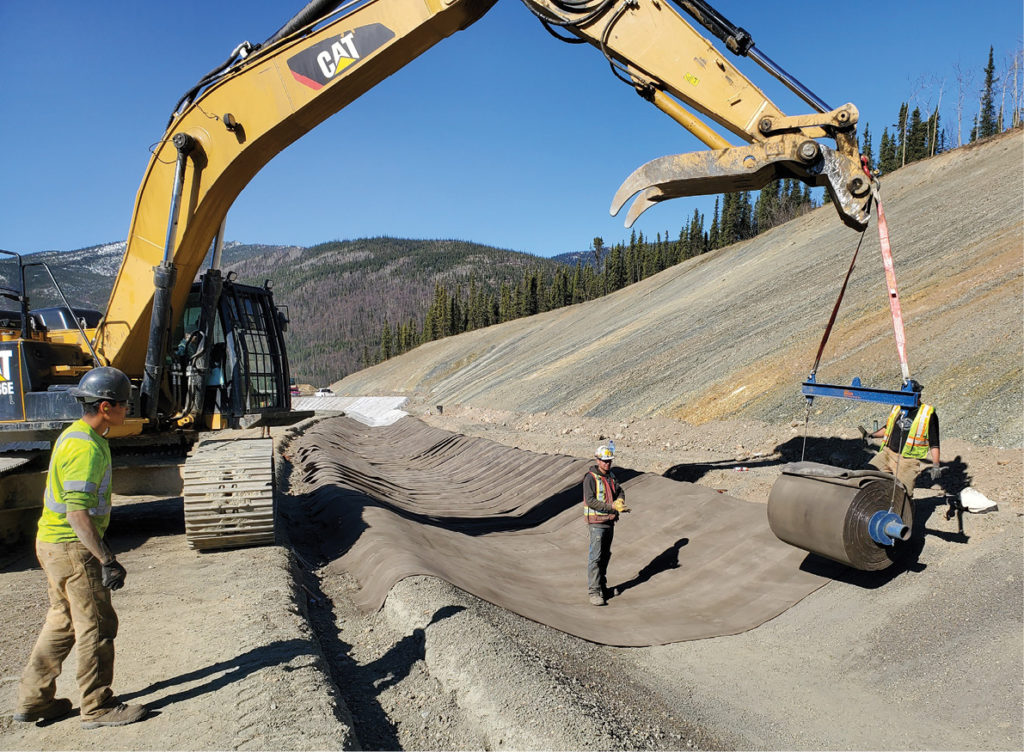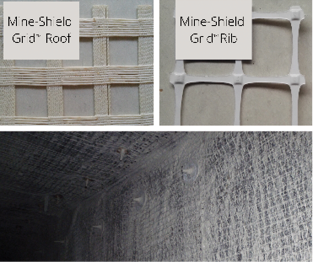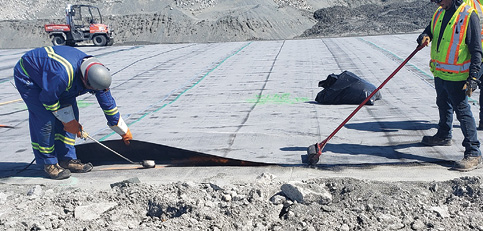JV Article: Titan Environmental Containment offers innovative solutions for high performing access roads, spillways and tailing facilities


Titan Environmental is a Canada-wide company with a suite of geosynthetic and civil construction products – including trademarked products– that offer innovative solutions to some of the most common problems in the mining industry.
Take, for instance, building an access road on swampy terrain or saturated sub-soils. The typical solution calls for aggregate, aggregate and more aggregate. Even then, long-term stability is hard to achieve and accidents in heavy haul trucks are inevitable.
But with Titan’s Swamp Grid geogrid, the volume of aggregate can be reduced by as much up to 40% and the roadbed is far more stable than a conventional base. Titan president Kelly Sitarz describes the product as a geotextile with high filtration properties and a high-strength biaxial geogrid surface.

“It’s a very cost-effective product,” Sitarz says. “You roll it out over the swamp like a carpet then pour aggregate over the Swamp Grid, which works like a snowshoe. It disperses the weight of the load. With a more stable structure you have less accidents.” A great example of this is a Mine Haul Road stabilization project in Northern Ontario using Titan’s Swamp Grid™. This project involved construction of haul roads built on compacted clay with blast rock/granite. These haul roads extend into a mine pit providing passage for rock dump trucks weighing several hundred tons. The conventional solution for this challenge would consist of using 1.0m of compacted crushed rock backfill (aggregate base) over the compacted clay subgrade. However, the Swamp Grid™ solution provided the mine with significant cost savings by allowing them to use 0.7m thick aggregate base rather than 1.0 m thick. This reduced overall construction costs while also decreasing environmental impact from aggregate harvesting and hauling.
Mine-Shield Grid is Titan’s other trademarked product and was developed for use underground in hard or soft rock mines. It is an alternative to the steel mesh, shotcrete and rock bolts typically used to stabilize tunnel roofs, ribs and walls. The product comes in two types of material – polyester and polypropylene with fire retardant and anti-static properties, the one ideal for roofs, the other for ribs and walls. Either product can be produced to specific roll lengths, widths and grid aperture opening without compromising the structural integrity.

“It’s a great advancement,” says Sam Bhat, Titan’s CTO of Geosynthetics. “Mine-Shield Grid is lightweight, high strength and easy to install. It can reduce the installation time for long wall screenings from weeks to days and is also much safer to handle than steel mesh reducing risk of injury.”
The specifications of both Swamp Grid and Mine-Shield Grid have been tested and verified by technical experts at several leading Canadian universities and accredited independent third-party laboratories. In addition, says Bhat, Mine-Shield Grid has been put to the test and been proven effective at underground mines in Australia since 2015.
Titan has rounded out its suite of products for mining applications by acquiring exclusive Canadian distribution rights to Concrete Canvas, which was developed in Britain, and Bituminous Geomembrane (BGM liner).
Ron Drewry, Titan’s Concrete Canvas Specialist, describes it as concrete on a flexible roll that hardens when properly hydrated. The product is used around the world in 54 countries in numerous applications, including the mining sector. In Canada, Concrete Canvas used in mining projects in British Columbia, the Yukon and Ontario for spillway and channel lining, among other things, or underground for mine vent wall construction to reduce ventilation costs, which are major cost in any underground mining operation.
Concrete Canvas is a multi-layered product with an impermeable PVC backing, a dry concrete interior interspersed among a 3D fibre matrix and a fibrous outer surface, which allows for hydration. It comes in thicknesses of five, eight and 13 millimetres, and three formats – bulk rolls, batched rolls or wide rolls.

Drewry says it is a low-cost, easy to install alternative to shotcrete, which is typically used in spillways and vent walls. “It’s extremely simple,” he adds. “You lay it out, cut it to length, seal it and hydrate it. It’s a lot easier to work with than shotcrete. It’s cleaner and takes less people to install.” He notes that, “One of the most impressive Concrete Canvas projects in Canada has been the Eagle Gold Mine spillway erosion protection project done in 2019. This one involved installation of 8,240m² of Concrete Canvas lining two lengthy spillways, which was completed in 11 days.” Drewry goes on to explain that the mine had considered using poured concrete with an applied coating however that option involved significant logistical requirements and much slower installation rates. Ultimately Concrete Canvas was chosen as it allowed the project to be completed quicker, and it was also more economical. A look into the project is offered in this video case study.
Bituminous geomembrane is an ideal mine cap or tailings pond liner. The interior comprises two layers of electrostatic bitumen and a single layer of non-woven polyester reinforcement pressed between outer layers of puncture-resistant polyester film. It can be installed at temperatures as low as minus 30 centigrade, which extends the window for constructing a tailings facility. It can be cheaper and easier to install than clay liners, especially if there is no clay on site, and there is no danger of erosion. Since BGM is not a conventional geomembrane it does require specialized installation techniques for efficient execution, which Titan has mastered. This was evidenced last summer at a pond dam raise lining project at a mine in Northern Ontario where Titan was called in to support a less experienced installer whose slow production rate were causing project delays. Putting their expertise with BGM to work, Titan’s field crew installed a record-breaking 9,347 m2 of BGM in 1 day, while adhering to stringent quality control and safety audits.
“We’re happy to have these products and installation expertise in our arsenal,” says Sitarz. Indeed, with BGM liner, Concrete Canvas, Swamp Grid and Mine-Shield Grid Titan has a suite of complimentary products for mining sector solutions extending from access roads to spillways and tailings facilities, and taken together, can reduce the capital and operating costs of a mine.
Apart from that, Sitarz points out that Titan’s products can reduce the carbon footprint of a mining operation and that is an increasingly important consideration in an era of heightened shareholder vigilance and ESG.
For collection of case Studies on mining projects using Concrete Canvas, Mine-Shield Grid and BGM visit: https://www.titanenviro.com/resource-centre/case-studies/
The preceding Joint Venture Article is PROMOTED CONTENT sponsored by TITAN ENVIRONMENTAL and produced in co-operation with Canadian Mining Journal. Visit www.titanenviro.com for more information.
Comments